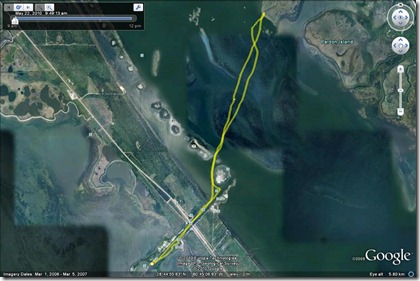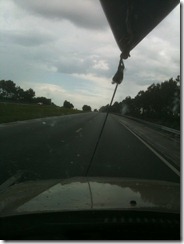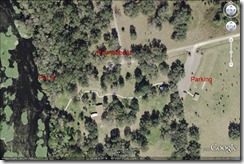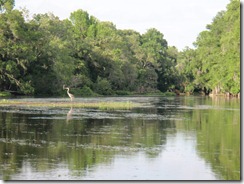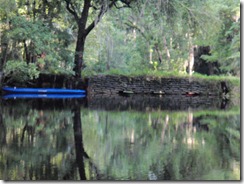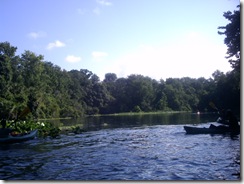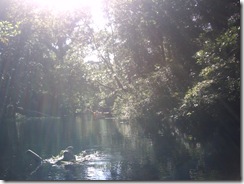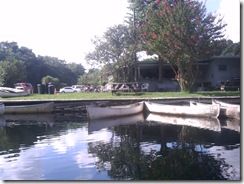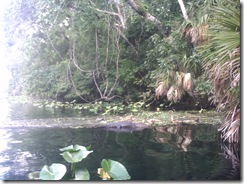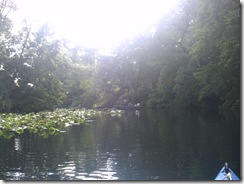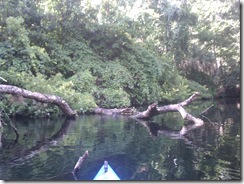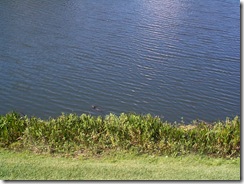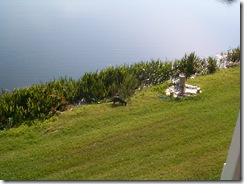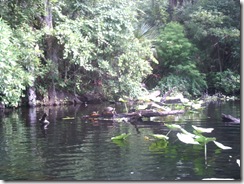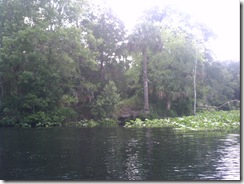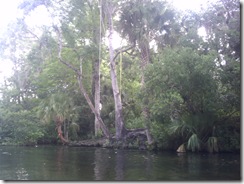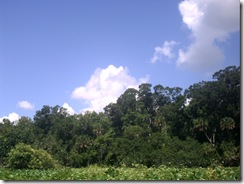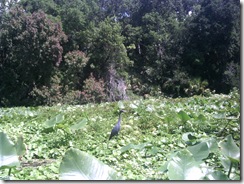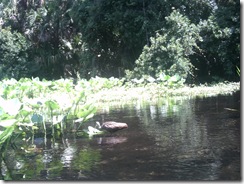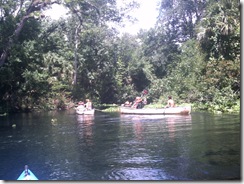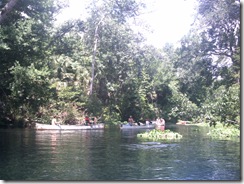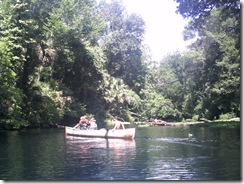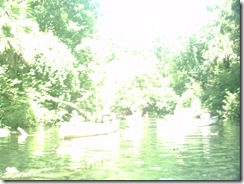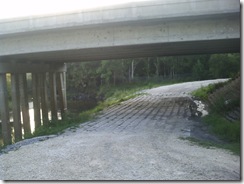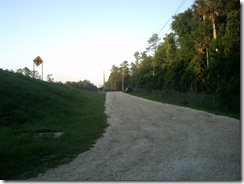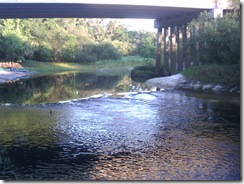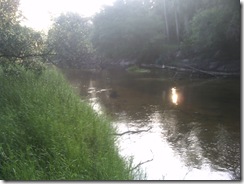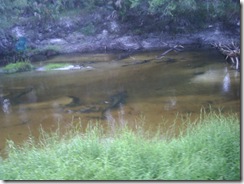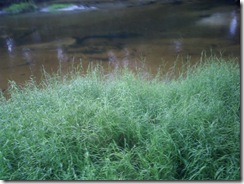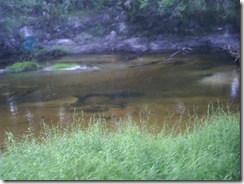Your cart is currently empty!
Category: alligator
-
Happy Birthday at Haulover
For my birthday morning, I took my daughter and a friend of hers to Haulover Canal.
View Haulover Canal in a larger mapAfter a long drive to pick up her Little Boy Friend*, we hit Subway for breakfast and to pick up lunch. At Subway, they gave me a Sharpie to put our initials on the lunch sandwiches, which, of course gave me the opportunity to write LBF on her friend’s – he seemed to have a sense of humor about it, she erupted in a chorus of “I can’t believe you did that!”
Kayaking and annoying the girl-child … life is good.
We were on the water by 10:00 and headed up the canal.
GPS tracking powered by InstaMapper.com
I put the kids in a tandem Pamlico while I paddled my Tarpon.
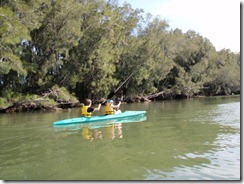 Shortly into the paddle, we spotted the first dolphin of the day.
Shortly into the paddle, we spotted the first dolphin of the day. And shortly after that, the manatees.
And shortly after that, the manatees.
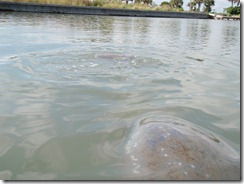
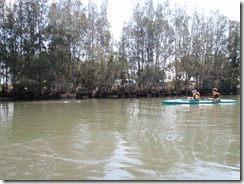 We left the manatees and the kids did a little exploring of Haulover’s unique shoreline.
We left the manatees and the kids did a little exploring of Haulover’s unique shoreline.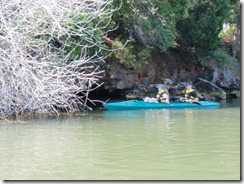 Shortly after this picture, they drifted closer to the branches and I heard the girl-child express her concern that a snake might drop on her. (You may express your ridicule in the blog comments and I’ll make sure she gets them.)
Shortly after this picture, they drifted closer to the branches and I heard the girl-child express her concern that a snake might drop on her. (You may express your ridicule in the blog comments and I’ll make sure she gets them.)Under the bridge and past the manatee observation deck, there was a pair … sporting.
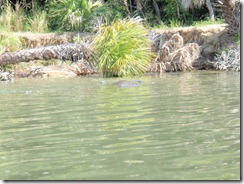 Some conversation in the other boat about what they were doing prompted the girl-child to ask me what I thought:
Some conversation in the other boat about what they were doing prompted the girl-child to ask me what I thought:“Well, sweetheart, when a mommy manatee and a daddy manatee love each other very much …”
“So you think they’re having sex too.”
A short way further along I spotted an alligator near the bank, but he sank out of sight before I could get a picture.
We exited the canal to the North – here are the mangroves where I stopped us to tell the kids the Mangrove Story.
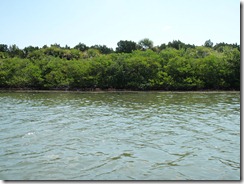 What’s the Mangrove Story? Well, I believe that we should take advantage of opportunities to educate children:
What’s the Mangrove Story? Well, I believe that we should take advantage of opportunities to educate children:“Mangroves are very important to the coastal eco-system, because their roots provide a protected environment that acts as a nursery for many different species of fish, crabs and shrimp.
“Interestingly, if you take a 10’x10’ piece of nylon netting and some lead weights and use them to submerge a body amongst the roots … in two weeks it’ll be nothing but bones from all those little baby fishes and crabs.
“You should remember that as you spend time hanging out with my little girl.”**
The kid seemed to be a good sport about this story, too, because, of course and on advice of counsel, the Mangrove Story is just friendly kidding.
Just before heading out into the lagoon, we came across a barnacle-covered piece of driftwood.

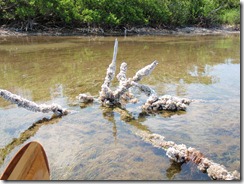 The wind was out of the NE today, so we headed in that direction, crossing the lagoon before stopping to drift back as we ate lunch.
The wind was out of the NE today, so we headed in that direction, crossing the lagoon before stopping to drift back as we ate lunch.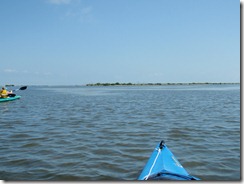 After lunch, on the way back, the girl-child will claim I fell in the water. I deny this charge. Here’s what happened:
After lunch, on the way back, the girl-child will claim I fell in the water. I deny this charge. Here’s what happened:Because I had forgotten to bring towels, I was unable to improvise a
ass-padseat cushion as I have recently. After the paddle across the lagoon, the lack was being felt, so I stood up to stretch my legs.The Tarpon is a very stable boat, so standing up is not foolish. I’ve stood in it to fish before with no problems on calm water, and it was quite calm today.
From my standing position I was enjoying the view of the clear, shallow water when I spotted what I thought was a small turtle. A second look showed that it was a large crab and since the water was so shallow and clear, I wanted to get a good picture of it, so I quickly sat down.
Standing in the Tarpon is perfectly okay … sitting quickly, not so much.
So, yes, part of me left the boat, but since it was only one leg and became wet only to the knee, while the other leg and the rest of me stayed in the boat, I do not believe this qualifies as falling out.
I subscribe to the philosophy that any exit in which my hair remains dry qualifies as a controlled-exit from the watercraft.
I did not get a picture of the crab.
After that incident, though, I did get a picture of a pelican in flight.
We also saw the second dolphin of the day off in the distance.
On the way back, the kids took a disturbingly close look at the mangroves.
 Of course
Of course I actually use a far more remote patch of mangrovesthere was nothing out of the ordinary for them to see.Back through the canal, now much more crowded with fishermen, and saw the third dolphin of the day off-shore as we loaded the car – or, more probably, saw the first one of the day again, but still good to see.
* I call all of the girl-child’s female friends her Little Friend and the males are referred to as her Little Boy Friend. I do this for two reasons: first, it saves me the trouble of trying to remember names; and, B, it annoys her to no-end. Yes, I’m lazy and cruel.
** The Mangrove Story is intended solely as an amusing anecdote and does not constitute an admission of guilt or any knowledge whatsoever about missing teenage boys who’ve hung out with my daughter.
-
Two Mondays on the Wekiva – Part II
For today’s trip on the Wekiva, I headed for Wilson’s Landing at State Road 46 to put in.
View Wekiva – Wilson’s Landing in a larger mapThe forecast all week calls for scattered thundershowers and halfway to drop my daughter off for her class and my couple hours on the water I ran into this.
 Traffic on the 70 MPH highway slowed to 40 as the storm cut visibility, but it soon cleared a little.
Traffic on the 70 MPH highway slowed to 40 as the storm cut visibility, but it soon cleared a little.The SR46 bridge is off-limits for boat launching, but Wilson’s Landing is close by. There’s no official boat launch at the park at this time, but Seminole County recently approved a quarter million dollars to build a pavilion and launch there.
Frankly, I think I could build a pavilion and canoe launch for a lot less than $250,000, but that’s a different issue.
Until it’s built, though, launching is a little … unofficial.
Parking is a good distance from the water, but there’s a paved sidewalk most of the way (if you have wheels) and terrain’s mostly level (unlike Wekiwa Springs State Park). There’s also a dirt road that continues past the parking to a roundabout that gets you about halfway closer to the water.
The sidewalk leads to a boardwalk over the water, but there’s a dirt path branching off it to the only clear area of shoreline in the park.
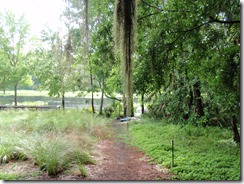 The path is surrounded by landscaping, but hasn’t been landscaped itself and there are no signs prohibiting boat launching, so I’ve assumed it’s okay to use this spot until the official launch site is built.
The path is surrounded by landscaping, but hasn’t been landscaped itself and there are no signs prohibiting boat launching, so I’ve assumed it’s okay to use this spot until the official launch site is built.The site itself, though, is pretty cramped right now and it’s a bit tricky to maneuver a large boat onto the water and back to shore for boarding.
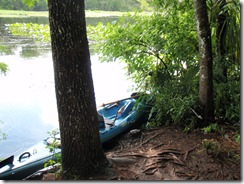 Once on the water, you can see that you’re only a short distance from the SR 46 bridge.
Once on the water, you can see that you’re only a short distance from the SR 46 bridge.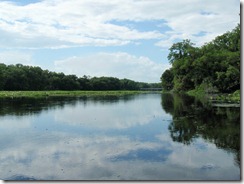 I had limited time for this trip, starting at 5:00 and needing to be off the water by 7:00 in order to pick up my daughter at 7:30, so I started upstream – planning to paddle until six and then head back to my launch point.
I had limited time for this trip, starting at 5:00 and needing to be off the water by 7:00 in order to pick up my daughter at 7:30, so I started upstream – planning to paddle until six and then head back to my launch point.GPS tracking powered by InstaMapper.com
Shortly into the trip, though, I found that staying by the right-bank had been a mistake and the channel I’d followed became clogged and impassable.
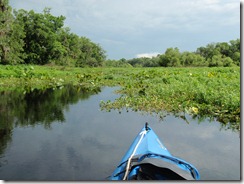 After heading back downriver, I decided to keep going that way, rather than retracing my path nearer the left-bank, so I headed for the bridge, taking a couple photos along the way.
After heading back downriver, I decided to keep going that way, rather than retracing my path nearer the left-bank, so I headed for the bridge, taking a couple photos along the way.
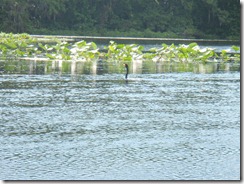
 The Wekiva’s an interesting river, because it can change from the very open river I started paddling in to a much closer, tree-lined river in a very short distance – as it does, just after the bridge, splitting into two channels with a tree-covered island between them.
The Wekiva’s an interesting river, because it can change from the very open river I started paddling in to a much closer, tree-lined river in a very short distance – as it does, just after the bridge, splitting into two channels with a tree-covered island between them. And then opening up again just as rapidly.
And then opening up again just as rapidly.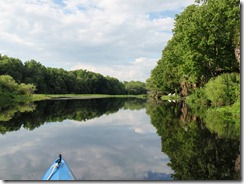 Ducks were out in force this trip and I saw quite a few of them.
Ducks were out in force this trip and I saw quite a few of them.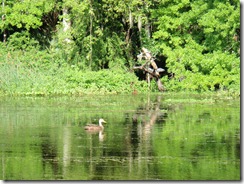 And farther down river, two deer were getting an early dinner.
And farther down river, two deer were getting an early dinner.
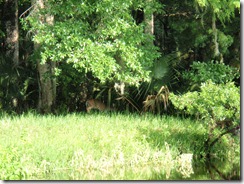 You’d think after almost forty years in Florida, I’d know what some of these damn birds are, but I really have no idea. I got a decent picture of this thing, though.
You’d think after almost forty years in Florida, I’d know what some of these damn birds are, but I really have no idea. I got a decent picture of this thing, though. And to think the mess I’d driven through earlier turned into this:
And to think the mess I’d driven through earlier turned into this: Ducks I can recognize, though, and this one seemed to not care at all about me.
Ducks I can recognize, though, and this one seemed to not care at all about me.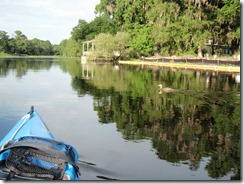
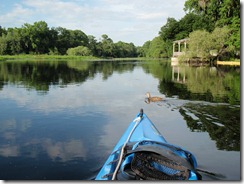
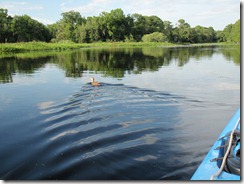 By this time it was six and time to turn around, but looking ahead I could see that I wasn’t nearly out of river yet …
By this time it was six and time to turn around, but looking ahead I could see that I wasn’t nearly out of river yet … Surely I could paddle a little farther and still make it back in time? Right? I decided to paddle until 6:15 and then head back.
And I’m glad I did, because just a little ways downstream an alligator left the reeds ahead for the far side at my approach.
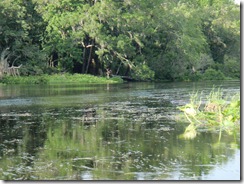
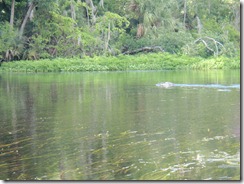 He was followed by a second, larger one, who reached the far shore and then paralleled my course for a while.
He was followed by a second, larger one, who reached the far shore and then paralleled my course for a while. Shortly thereafter, I ran across this plant – not sure what it is, but it looks nice.
Shortly thereafter, I ran across this plant – not sure what it is, but it looks nice.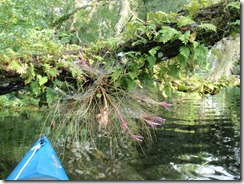 At this point, it’s 6:08, so I decide to turn around and head back … mostly because my watch is slow and it’s really 6:12.
At this point, it’s 6:08, so I decide to turn around and head back … mostly because my watch is slow and it’s really 6:12.Remember all those big open spaces on the river … well, now the current’s against me and the wind seems to have picked up and is funneled between the trees and I have to hurry back to the put in.
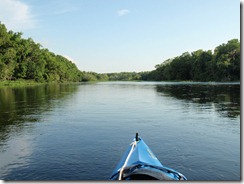 Why does this little stretch of river seem so much harder to paddle than the open-ocean side of Honeymoon was Friday?
Why does this little stretch of river seem so much harder to paddle than the open-ocean side of Honeymoon was Friday? Finally, ahead of me, the river splits and I paddle into the narrower channel on the right-bank. Once I’m through this tree-covered area, I’ll be going under the bridge and then it’s just a few hundred yards to the park.
 Not quite at the right split yet, and the homeowners have built a wall across the river – probably too many boats cruising through ignoring the No Wake signs. So I have to backtrack and get out of this dead end, but if I hadn’t taken it, we wouldn’t have this picture of a pony in someone’s back yard.
Not quite at the right split yet, and the homeowners have built a wall across the river – probably too many boats cruising through ignoring the No Wake signs. So I have to backtrack and get out of this dead end, but if I hadn’t taken it, we wouldn’t have this picture of a pony in someone’s back yard.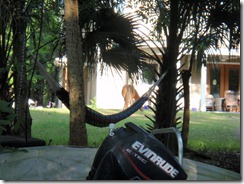 Yes, the best picture I could get was of the horse’s ass. I’m in a hurry and have to get off the water by 7:00 or I’ll be late picking up my daughter – give me a break.
Yes, the best picture I could get was of the horse’s ass. I’m in a hurry and have to get off the water by 7:00 or I’ll be late picking up my daughter – give me a break.As an aside, is that really a pony, or is it a demondonkey?

I’m just asking.
Saw another large alligator cruising ahead of me, but he submerged before I got close enough for a photo. And now that I’m hurrying, fighting against the current and the wind to get back and off the water by 7:00 so I won’t be late for that 7:30 pick up, there’re smaller gators on every freakin’ dock I pass, it seems. No time for pictures of them, though.
Finally, I’m in the right channel and reach the bridge.
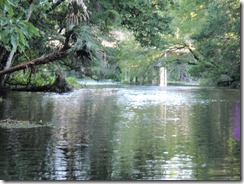 And back to Wilson’s Landing where I can get off the water.
And back to Wilson’s Landing where I can get off the water. Yes, that’s the target I have to line my 16’ boat up against, get close enough sideways to step out onto land, then maneuver the boat around to pull it out. I didn’t say it was an easy site.
Yes, that’s the target I have to line my 16’ boat up against, get close enough sideways to step out onto land, then maneuver the boat around to pull it out. I didn’t say it was an easy site.Off the water, drag all the gear back to the roundabout, load the car and ready to drive only a few minutes late.
 My schedule had some buffer time in it, so I’m able to make it with a couple of minutes to spare, arriving to pick my daughter up at 7:28.
My schedule had some buffer time in it, so I’m able to make it with a couple of minutes to spare, arriving to pick my daughter up at 7:28. At which time, I sit around and wait until 7:45 because her class ran long.
-
Wekiva River
After nearly soiling myself passing a very large gator at close range on the Econlockhatchee, I decided something more leisurely and sedate was in order, so I headed for Wekiwa Springs State Park to paddle the Wekiva River.
The springs and the river actually do have different names, it isn’t an alternate spelling. Wekiwa refers to the springs — water coming out of the ground; while Wekiva means water flowing over the ground.
If you want a peaceful, tranquil Florida river experience, the Wekiva is a good choice … unless it’s a Saturday during Summer. Wekiwa Springs State Park frequently closes due to capacity being reached on Summer weekends and the river teems with boaters … most of them in rented canoes with no idea what they’re doing and less interest in the serenity of nature.
Near the headwaters of the Wekiva you have a choice of putting in at either the State Park or Wekiva Marina (about a mile downstream from the springs).
I chose the State Park because the fee to put in is a couple dollars less. If you put in at the Marina and then want to paddle to the Park, there’s a small fee to enter the Park as well.
One issue with launching your own boat from the State Park is that the water is some distance from the parking. There’s also a hill involved and the trail is rather soft sand in some places. It’s not that bad getting to the water, since it’s downhill from the parking lot … the bad part comes later.
The put-in is on the Wekiwa Springs pond, just below the swimming area.
Since my little misadventure on the Econ had eaten up some of my time this morning (and thankfully that was all that was eaten), it was after 9:00 AM when I got to the springs and people were already on the water. It was still early enough, though to get a bit of mist and early morning sunshine through the trees.
About 3/4 of a mile from the springs, Rock Springs Run joins the Wekiva. This is a smaller, less-traveled tributary that I enjoy paddling and I started up it a bit before returning to the Wekiva.
A full mile from the State Park is Wekiva Marina, where you can also put in or rent a canoe.
Shortly past the marina, I came across a small alligator — a much more pleasant encounter than the one earlier in the day. In fact, on most trips down the Wekiva I’ve encountered a small gator in this area, just downstream of the marina.
It’s at this point in writing this blog entry that I come to the realization that the little Argus Bean camera I got for these trips just isn’t going to do it for me. Most of the pictures I took on this trip didn’t come out well, so I’m going to have to try something better.
After pointing out the little gator to the next group of paddlers coming down the river, I leave him behind and encounter a new form of wildlife — kayaker without PFD:
If you look closely, you can see her head behind the nice Fish and Game officer’s boat … her head’s right next to the officer’s ticket book, which she got a very good look at.
Is it really such a hardship to have a PFD in the boat?
Past the legal action, I saw bubbles start to break the surface of the water near the shore, then a stream of bubbles race across the width of the river. A line of bubbles breaking the surface usually means an otter and a bit of patience tracked him down when he surfaced near a fallen tree to munch on a fish.
I love watching otters and had the good fortune to once rent an apartment that had been built around a natural pond that acquired a family of them. For several months I was able to watch them from the comfort of my balcony:
After passing the otters, I saw some turtles on a log:
This is the obligatory, Florida, Turtle on a Log picture. I do not plan to take or post any more pictures of Turtle on a Log, no matter what river I see them on.
Now, don’t get me wrong, I like seeing Turtles on a Log — no matter how many times I see them, it’s a nice reminder that I’m on the water, away from the city. But, let’s face it, there’re a lot of Turtles on a Log. And anyone who paddles, especially in Florida, has seen more than their share already, so pictures of them aren’t really necessary.
So, from time to time, if I feel it’s useful for the ambiance of the trip report, I’ll just throw in:
You’ll know what I mean and it’ll save everyone’s time and Internet bandwidth. If you truly feel compelled to see another picture of Turtle on a Log, you can click the link and come right back here to one.
Of course, I’ll still take and post a picture if I feel it’s noteworthy, for instance if I see Unusually Large Turtle on a Log or Very Large Number of Turtles on a Log. Definitely if I see the very rare: Log With No Turtle.
I started paddling again …
(see how nicely that works?)
About 1/2 a mile downstream of the marina, the river appears to split around an island you can recognize by the lone palm tree next to a bare bank:
The left channel is the main, navigable river, but the island is a frequent stop to rest and relax. Farther along its shore are several rope swings and later in the day this spot will be packed with people picnicking and playing in the water.
The rest of my paddle down river is mostly uneventful …
<Turtle on a Log>
<Turtle on a Log>
<Turtle on a Log>… though I do get my best quality pictures of the day out of the Argus Bean when I come to an open area of the river and want to capture the beautiful sky I’m paddling under:
After a couple hours of paddling …
<Turtle on a Log> ^ 10
I do encounter some very tolerant birds that let me get quite close for a picture. These are without any zoom:
Once back between the marina and the park, I once again encounter the large crowds on the river this summer weekend. The attendant at the springs put-in told me they had eighty boats on the water — possibly an exaggeration.
One day, I’m going to come here and just paddle the mile between the park and marina, back and forth, all day, watching the people in the rented canoes. Some know what they’re doing, but for others it’s a crap-shoot whether they’ll make it off the river alive.
Best quote of the day (from a wife in the front of a canoe with a paddle across her lap):
"You’re heading right for another tree!"
The tree in question was at least fifty feet away and the look on the husband’s face was priceless.
My favorite was this lady. She has three kids with her in two canoes. She has tied the canoes together and is the only one paddling — the kids mostly just sit there with their paddles. Here she is crossing the river in front of me:
Now, here she is crossing the river back the other way:
And back:
Here the Bean failed me again, but she’s recrossing the river right in front of another canoe (keep in mind her two are tied together and the oncoming canoe has the current behind it). I’m cringing at this point, waiting for the clothesline flag to be thrown and ready to assist the soon-to-be victims.
Luckily, the oncoming paddler was able to slow down enough to avoid disaster.
Once back at the State Park put-in, the truly horrid part of the trip is facing me: getting the boat back to the car.
After trudging up the hill to retrieve the kayak cart from the car and back down to the put-in, I make sure everything’s secure on the boat and start the trek … uphill … through the soft, soft sand.
At the top of the initial hill, there’s a choice to be made. I can turn right past the concession stand and then up the narrower, steeper trail to where I parked, or I can go left through a picnic area — that way is longer, but not as steep.
I’m 41-years old, out of shape and need the exercise, I take the hill. Besides, they’re grilling in the picnic area, I can smell it. I’m hungry after the morning’s paddling and the turkey sandwiches waiting in my cooler just aren’t what I want. If I have to drag this damn boat past burgers and barbeque, there’s going to be an Incident.
So up the hill. But not all at once. The goal is to get the heart pumping, not exploding.
First, the short pull across level ground to the restrooms, which is an excellent excuse to stop for a moment. Then start up the hill to the gate and pause again, looking longingly back at the hot dog cart outside the park’s concession. If they were grilled, I’d be all over it, but they’re boiled and even the turkey in the cooler’s more appetizing than that.
Now up the hill to the halfway point, where I wheeze for a little while, muttering about how if I’d taken the other path I’d be eating a burger right now while fending off its owner with a BBQ fork.
And one final pull to the parking lot where I load up the car and settle in to the air conditioning to eat my turkey sandwich. Yum.
-
Econlockhatchee River (lower) — Failed Trip
The Econ has not been kind to me this week. After failing earlier in an attempt to paddle the upper stretch, I returned this morning for the lower segment, which is 11-miles and runs from Snow Hill Road to State Road 46, a short ways down the St. Johns River from where the Econ flows into it.
The put-in at Snow Hill Road is very nice, with gravel entries on either side of the road and under the bridge.
Despite some rain during the week, the water level was still very low when I arrived, so low that the little dam under the bridge was visible.
Water level and debris had been the problem when I tried to paddle the upper segment, but I decided to try anyway. The current water level had been okay for paddling the middle segment that runs through the Little Big Econ State Forest, so I figured it was worth a try.
Because the shore of the put-in below the little dam is mostly rock and concrete for erosion control, I put in above the dam and "shot the rapids" — this is Florida, we take what we can get.
Shortly after taking off, only a few minutes down river, I come to a tree mostly blocking the way, but it’s been down a while and previous paddlers have cleared some of it near the left bank and there’s about six or eight feet of clear water on that side.
As I get closer, I see that there’s a stump dead center of this cleared space and it looks over a foot across, so I start pondering how to get by it; is my better track going to be on the left near shore or on the right toward open water? With the current pushing me toward the gap, I look down river to see what’s next and choose my line … then I notice something and have a new thing to ponder:
Why does a stump need eyes?
This is, indeed, a riddle … a quandary, even, that I puzzle over as the stump slowly sinks out of sight.
I stop paddling as the current takes me through the gap and I look down.
Under two, maybe three, feet of tea-colored water, half a paddle-length from the edge of my boat, is an eat-me category alligator. (Actually, from my perspective at the time, he looks more like he’s in the Betty White’s Cow category.)
He’s not as big as my boat, a 16.5′ Tarpon, but he’s bigger than most of my boat, so my heart’s racing a bit.
Now, intellectually, I know that he doesn’t want to hurt me and the reason he’s down on the bottom is so I won’t see him and will leave him alone. I know this … but fresh in my mind at the time is this message from over on the Green Wave about a gator surfacing and putting four holes in the bow of 14.5′ Perception at Alexander Springs.
I’m sure the gator in that incident wasn’t looking to hurt anyone, he just got startled and wanted to get away, so he lashed out at what he thought was the threat and then retreated.
So here I am floating by my gator today, trying ever so hard not to appear threatening (or tasty). In fact, I’m thinking to myself: "Hello, Mr. Alligator — this is just a big, blue log floating innocently down the river; soon it will be gone and you can go on about your business. Pay no attention to that mammal on top of the log, he tastes bad and is high in cholesterol."
Once past, I breathe a sigh of relief and round the next bend, glad to put him behind me. As I round the bend, I startle a deer drinking at the shoreline. She stares at me for a split-second, then bounds off into the brush. And it’s at this point that I remember I have a camera, so I head for the beach where the deer was drinking, tie up my kayak and walk back along the shoreline (keeping some distance from the actual water) until I find the alligator again — he’d drifted a bit downstream from where I first saw him. He’s still submerged, but is visible in the pictures:
As I get back in the boat and start paddling again, I begin to think:
Narrow river + shallow water + large alligators + solo paddler = ?
What do these things add up to? Stupid people doing stupid things.
See, I have no doubt at all that I’ve been on the water with gators that big before … many times. I’ve probably paddled right over them. The difference here is that the water’s not deep enough and the river’s not wide enough for the gator to get far enough from me for him to feel safe … and that’s when he’s going to hurt me, when he thinks I’m a threat and he can’t get away.
I’m barely into this trip and I’m thinking about another eleven miles of narrow, shallow water … what’s the likelihood in these conditions that I’ll be paddling hard and deep to get around some obstruction and whack one of these guys in the head with my paddle? Or that I’ll be unable to see below the surface ahead of me due to the sun’s glare and wind up running into one? Do I like these odds?
So, since one of my life-goals is to not be the guy on the six o’clock news story that everyone else in town shakes their head and mutters "dumb ass" about, I decide this isn’t the right time to take this trip. On another day, when there’s more water and maybe another paddler, I’ll be back.
At the time, though, I have another problem. Ahead of me is eleven miles of shallow, narrow water with an unknown number of large alligators … behind me might only be a few hundred yards of paddling, but I know exactly what’s in the very shallow, very narrow river.
I start paddling back, keeping a watchful eye out … no gator. I pull onto the bank a couple times so I can walk ahead and scout the water … no gator. I get past the area that I first saw him in … no gator. I get to within view of the dam … no gator. I get through the gap in the dam, under the Snow Hill Road bridge and up to the beach … no gator.
So the question in my mind for the rest of the day: I didn’t see him, so how close to the bottom of my boat was he when I went right over him?
-
Econlockhatchee River (middle)
Today’s activities started as a trip to the dog park with the furry family members. If you’re in Central Florida with a dog, Fleet Peeple’s Park in Winter Park is where to go. This is a huge off-leash park with lake access — absolute heaven for the puppies.
So we loaded up the car with a Border Collie, a German Shepherd and a Huskie/wolf-mix.
Yes, we have the dog to herd the sheep, the dog to guard the sheep and the dog to eat the sheep — we’re only missing the sheep … but we do have seven cats in the house, so I suppose that makes up for it.
Unfortunately, the posted off-leash hours don’t include from 10AM to 4PM on weekends and holidays — it’s technically an on-leash park at those times. This normally isn’t enforced, but today someone was having a cook-out / party there and complained, so the ranger had to enforce the rule. The dogs were disappointed.
After a short stop at another dog park (no lake), we headed home and I decided to take the boat out for a few hours.
Econlockhatchee River (middle segment)
Florida Greenways and Trails Guide
The Econlockhatchee (Econ) can be divided into three segments for paddling, this middle segment runs from S.R. 419 in Oviedo to Snow Hill Road in Chuluota:
The Econ’s a tributary of the St. John’s River, so it runs mostly north. This segment runs north from 419, then turns east to Snow Hill Road, flowing through the Little Big Econ State Forest (not a typo). Most of the route being state forest, there’s only one point, other than the put-ins where human construction impinges on the natural beauty.
Access at 419 is just east of the bridge: It’s a few hundred feet from the parking to the water, but down a gentle, grass slope. From here, you can paddle upstream (South) towards Highway 50 or downstream (North and then East) to the Snow Hill Road access (about 8 miles), which is the direction I took. The upstream route is more overgrown and less-travelled, though.
It’s a few hundred feet from the parking to the water, but down a gentle, grass slope. From here, you can paddle upstream (South) towards Highway 50 or downstream (North and then East) to the Snow Hill Road access (about 8 miles), which is the direction I took. The upstream route is more overgrown and less-travelled, though.Once out of site of the bridge, the human world disappears and you enter the real Florida, not the plastic of the theme parks:
 This is a blackwater river, which means that the tannins make the water a deep brown or black when it’s deep; and it’s fed mostly by run-off, not springs, so the water level is very dependent on the rains. This being May, the end of the dry season, the water level was quite low, making the bottom visible for most of the trip — since the water’s so murky seeing bottom means a depth of only a foot or two.With the water so low, there were plenty of white sand beaches and sandbars that would make excellent camping spots. In Florida, it’s legal to camp below the high-water mark. Speaking of the high-water mark:
This is a blackwater river, which means that the tannins make the water a deep brown or black when it’s deep; and it’s fed mostly by run-off, not springs, so the water level is very dependent on the rains. This being May, the end of the dry season, the water level was quite low, making the bottom visible for most of the trip — since the water’s so murky seeing bottom means a depth of only a foot or two.With the water so low, there were plenty of white sand beaches and sandbars that would make excellent camping spots. In Florida, it’s legal to camp below the high-water mark. Speaking of the high-water mark: Most of the route has the high, steep banks cut by river running deep when the rains come and a lot of the trees you go under in May you’ll be pulling over come August or September:
Most of the route has the high, steep banks cut by river running deep when the rains come and a lot of the trees you go under in May you’ll be pulling over come August or September: Midway through the trip, the river turns from a northerly to easterly course and fully enters the State Forest. This is the area where there’s the most wildlife and where I’ve seen most of the alligators on this route. On today’s trip we only saw one gator, but he was big enough to satisfy me.
Midway through the trip, the river turns from a northerly to easterly course and fully enters the State Forest. This is the area where there’s the most wildlife and where I’ve seen most of the alligators on this route. On today’s trip we only saw one gator, but he was big enough to satisfy me.I place alligators into three categories. First, there’s “cute” — these are the ones that are interesting to look at and small enough that they don’t even give me pause. Next there’s “hurt-me” — these guys are big enough where I keep some distance, because I know if I scare them they might attack out of fear or cause some damage trying to get away. Finally, there’s the “eat-me”-category — these are the ones that could be considering how I’d taste after I marinated under a sunken log for a couple weeks.
Now, in general, alligators are shy and want nothing to do with people — and attacks on people are usually the result of the people doing something incredibly stupid. Take the guy in South Florida who was attacked after going swimming naked in a pond in the middle of the night — then the other guy was attacked after going swimming naked in a pond in the middle of the night … wait, that was the same guy. He did it twice. Like I said: stupid people doing stupid things.
Just the same, when they reach a certain size, it’s best to leave them be.
The gator we saw today definitely fell into the “eat-me” category. We came around a bend and he was near shore with his head and a couple feet of back out of the water sunning. As we glided past, he slowly sank lower and lower into the water until he disappeared.
Midway through the easterly stretch, you’ll come across the only sign of human construction between the two access points. Several trails through the State Forest converge at a pedestrian bridge across the river:
 This is a good spot to get out and stretch your legs for a bit or hike along the trails.
This is a good spot to get out and stretch your legs for a bit or hike along the trails.About a dozen or so bends in the river past the pedestrian bridge you’ll sight the Snow Hill Road bridge and the access point there:
 The banks here are steeper than at the 419 bridge, so the county’s added erosion-control measures under the bridge:
The banks here are steeper than at the 419 bridge, so the county’s added erosion-control measures under the bridge: The concrete and wire on the slope will tear up the bottom of a boat, so I was happy to see that they’d covered part of it with soil and grass to make a path to the water. The last time I was here, the slope on the right was all rock and wire, so I had to pull up through the trees far to the side — the six-inch banana spider whose web I stumbled through wasn’t happy about that. This time it was much easier.
The concrete and wire on the slope will tear up the bottom of a boat, so I was happy to see that they’d covered part of it with soil and grass to make a path to the water. The last time I was here, the slope on the right was all rock and wire, so I had to pull up through the trees far to the side — the six-inch banana spider whose web I stumbled through wasn’t happy about that. This time it was much easier.Today’s trip took a bit over two hours — if you paddle easy or stop frequently it could last three or four.
The river bends a lot and there are frequent obstructions so intermediate paddling skills are called for, especially at high-water when you won’t be able to get out and stand in the water to get past obstacles.
If you’re looking for a taste of wild Florida, this is a good choice.
